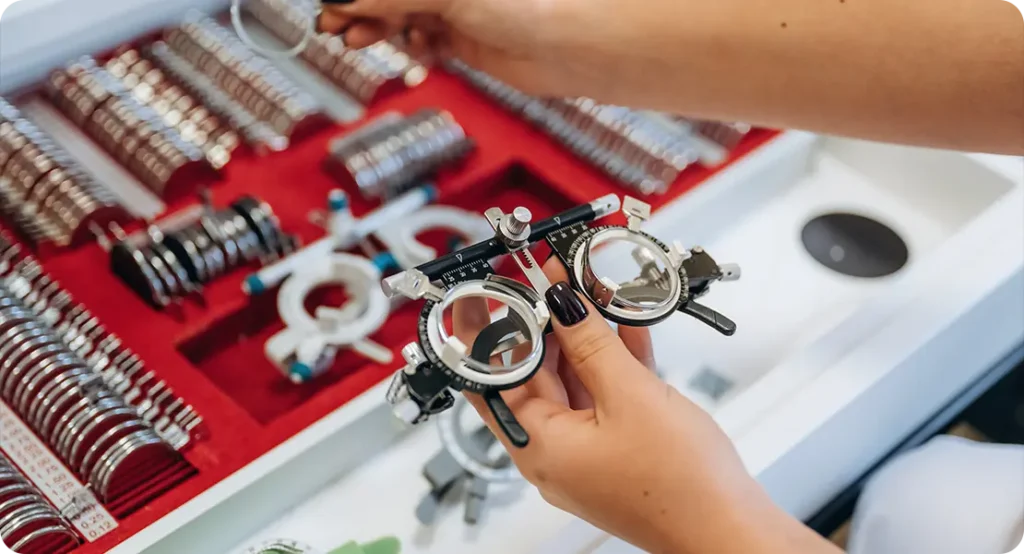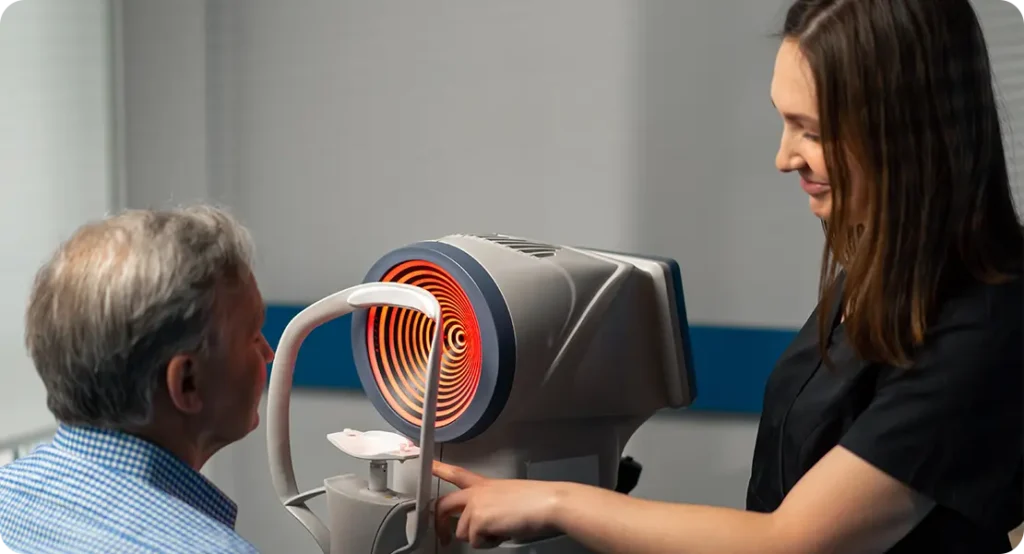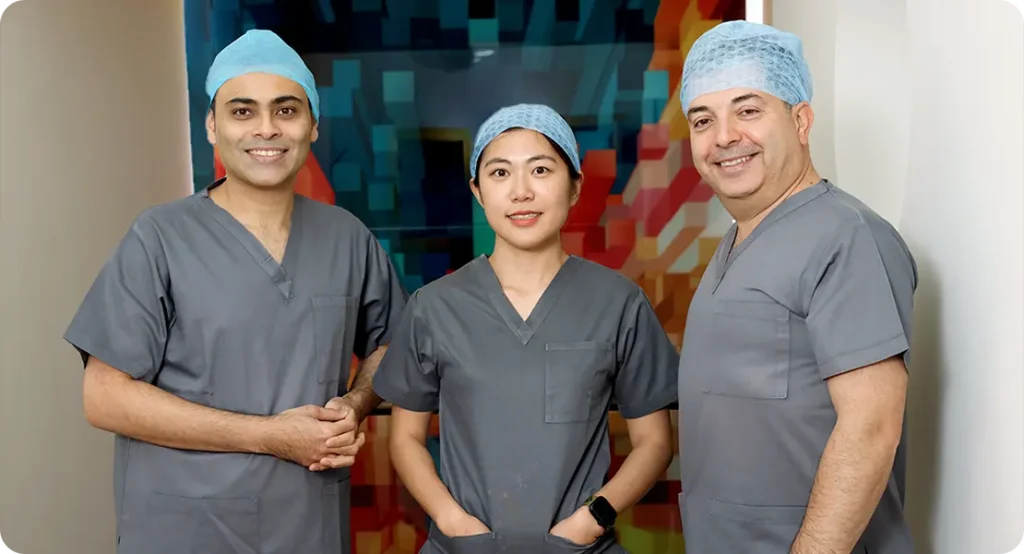When it comes to cataract surgery, one of the most talked-about aspects is the intraocular lens (IOL) that replaces your cloudy natural lens. With so many options available and important decisions to make, it’s no wonder patients have a long list of questions. Whether you’re exploring private or NHS treatment, or simply trying to wrap your head around the different lens types, I’ve answered 19 of the most common questions people ask cataract surgeons about IOL lenses. Let’s get into it.
1. What is an intraocular lens (IOL)?
An intraocular lens, or IOL for short, is a synthetic lens implanted into your eye during cataract surgery to replace the natural lens that’s become cloudy. It’s made from clear, biocompatible materials like acrylic or silicone. Once it’s in place, it stays there permanently and doesn’t need maintenance. Essentially, it acts as your new focusing system, allowing light to pass through clearly.
Before surgery, your surgeon will measure your eye to calculate the right IOL power. These measurements are incredibly precise and help ensure you get the best possible visual outcome. Think of the IOL as your eye’s new set of spectacles, but inside your eye. It won’t degrade over time, and you won’t feel it once it’s in.
There’s a wide range of IOLs available today, each offering different benefits depending on your lifestyle, vision goals, and whether you’re being treated on the NHS or privately. That’s why understanding your options is key before going ahead. Not every lens will suit every patient, and your surgeon will help guide that decision.
In the UK, cataract surgery is one of the most commonly performed procedures, and the use of IOLs has become highly refined. These lenses have come a long way in recent decades, with newer models designed to reduce dependence on glasses or contact lenses. So you’re not just getting clearer vision—you’re potentially getting more convenience too.
2. What are the different types of IOL lenses?
There are several types of IOL lenses, each offering different visual benefits. The most basic is the monofocal IOL, which provides clear vision at one distance—usually set for distance vision—so you’ll likely still need reading glasses. Monofocal lenses are what you’ll typically receive through the NHS.
Then there are multifocal IOLs, which are designed to provide vision at multiple distances. These are often chosen by people who want to reduce their reliance on glasses altogether. While they offer convenience, they can sometimes cause halos or glare, especially when driving at night. These lenses are typically only available privately in the UK.
Another option is the toric IOL, which is specifically designed to correct astigmatism. If you have a significant level of astigmatism, a toric lens can drastically improve your visual outcome compared to a standard lens. Again, toric lenses are more common in private care, though occasionally they might be offered on the NHS under special circumstances.

There are also extended depth of focus (EDOF) lenses, which provide a continuous range of vision from far to intermediate, with fewer issues like glare. These lenses are relatively new and are often seen as a middle ground between monofocal and multifocal lenses. Deciding between them involves discussing your visual needs and lifestyle with your surgeon.
3. How do I know which IOL is right for me?
Choosing the right IOL depends on your daily routine, personal preferences, and any pre-existing eye conditions. If you don’t mind wearing glasses after surgery and prefer a straightforward option, a monofocal lens might suit you well. It offers excellent distance vision and is the standard option on the NHS.
If you’re hoping to ditch glasses completely or want more freedom, a multifocal or EDOF lens may be a better choice. These options are usually only available privately and involve an extra cost, but many patients find the added visual range worth it. They do, however, come with potential trade-offs like glare or reduced contrast in low light.
Astigmatism is another factor to consider. If you have a moderate to high level of astigmatism, a toric IOL could dramatically improve your vision. Not everyone realises that untreated astigmatism can still leave you dependent on glasses even after cataract surgery, so this type of lens can make a big difference.
Your cataract surgeon will guide you through your choices based on detailed eye measurements and a discussion about your expectations. It’s not a one-size-fits-all situation, and what’s right for one person might not be ideal for another. Make sure you’re honest about your priorities—whether that’s driving at night, reading without glasses, or managing other eye conditions.
4. Are premium lenses worth the extra cost?
Premium lenses—like multifocal, EDOF, and toric options—can significantly enhance your post-surgery experience, especially if your goal is visual independence. Many patients find that the convenience of not needing glasses for most activities justifies the additional cost. These lenses are especially popular among people who live active lifestyles or frequently drive, travel, or work on screens.
That said, not everyone is an ideal candidate for premium lenses. Some people may be more sensitive to glare or halos, especially at night, which can be a side effect of certain multifocal IOLs. If you have other eye conditions like macular degeneration or glaucoma, these lenses may not work as well, so the benefits may not outweigh the cost.
In private care, your consultant will take time to assess your suitability for premium lenses and help you weigh the pros and cons. You’ll usually receive a more customised approach compared to the NHS, where standard lenses are used as part of cost-effective treatment pathways.

Ultimately, whether a premium lens is “worth it” comes down to how much you value visual freedom and whether you’re willing to pay out of pocket. If being less reliant on glasses would dramatically improve your lifestyle, many people consider it a worthwhile investment.
5. What’s the difference between NHS and private cataract surgery when it comes to IOLs?
The most noticeable difference is in the choice of lenses. On the NHS, cataract surgery typically involves the use of monofocal lenses. These are excellent at restoring vision at one distance—usually far—but you’ll likely still need glasses for reading or intermediate tasks like using a computer.
In contrast, private cataract surgery offers a much wider range of lens options, including multifocal, toric, and EDOF lenses. You can also expect more time with your consultant and a greater emphasis on tailoring the procedure to your individual lifestyle and visual goals. This flexibility allows for a more customised outcome.
Waiting times are another big difference. On the NHS, you might be waiting weeks or even months for surgery, whereas private clinics can often schedule your procedure within days. Plus, the continuity of care is usually stronger in the private sector—you’ll often be treated by the same surgeon throughout the process.
That said, the NHS provides high-quality cataract surgery, and for many people, it does the job very well. If you’re content to wear glasses afterwards and don’t have complex visual needs, NHS treatment is a solid option. But if you want more say in the outcome, private care gives you more control.
6. Can I have one type of IOL in one eye and a different one in the other?
Yes, and it’s actually more common than you might think. This approach is called “blended vision” or “mix and match,” and it involves using different IOLs in each eye to maximise your range of vision. For example, one eye might receive a monofocal lens set for distance, while the other gets one set for near or intermediate tasks.
Some surgeons also combine a monofocal in one eye with a multifocal or EDOF lens in the other. This strategy can offer the benefits of both lens types—providing distance clarity with reduced visual disturbances from the premium lens. It does take some time for your brain to adapt, but many patients find the results very effective.
However, this mixed-lens approach isn’t suitable for everyone. Some people find the visual differences between the two eyes disorienting. Your surgeon will assess your eye health, vision needs, and ability to neuro-adapt before recommending this route. They may also simulate the results using contact lenses prior to surgery.
If done well, mixed IOL strategies can deliver a great balance between visual clarity and spectacle independence. The key is a thorough pre-operative consultation to ensure it’s the right fit for you. Always ask your surgeon if they’ve successfully performed this kind of combination before.
7. Will I still need glasses after getting an IOL?
That depends on the type of lens you choose. If you opt for a standard monofocal IOL, which is common in NHS treatment, you’ll likely need reading glasses and possibly glasses for intermediate vision. These lenses are designed to focus clearly at a single distance, often for driving or seeing things far away.
If you choose a multifocal or EDOF lens, there’s a good chance you’ll be able to reduce or even eliminate your dependence on glasses. These lenses are designed to handle different distances, so many people find they no longer need specs for everyday tasks like reading, computer work, and going for walks.

However, no lens is perfect, and there may still be times when glasses are helpful—for instance, when reading very fine print or in low-light conditions. Some people also find that they still prefer glasses for specific tasks, even if their general vision has improved.
Ultimately, it’s about trade-offs. If total freedom from glasses is your goal, speak to your surgeon about lens options and whether you’re a good candidate for the more advanced types. And remember, sometimes a minor spectacle prescription can fine-tune things even further, especially after your eyes have settled post-surgery.
8. How long does an IOL last?
Once an intraocular lens is implanted during cataract surgery, it’s designed to last for the rest of your life. These lenses are made from extremely durable materials that don’t degrade over time, meaning they stay stable and clear inside your eye for decades. Unlike contact lenses or glasses, they don’t require replacement or adjustment.
Most people will never need to think about their IOL again after surgery, apart from routine eye checks. It’s a one-time procedure that restores vision and eliminates the cloudy natural lens permanently. This long-lasting feature is one of the reasons cataract surgery is such a reliable and low-maintenance solution for vision loss.
However, some people may experience a condition called posterior capsule opacification (PCO) months or years after surgery. This isn’t the lens failing, but rather a clouding of the membrane behind the IOL. It can be easily treated with a quick laser procedure called YAG capsulotomy, which restores clarity without touching the lens itself.
So in short, IOLs don’t wear out or stop working. Once implanted, they’re there for good. Any future vision changes are far more likely to be due to other age-related eye conditions rather than the IOL itself.
9. What is a toric IOL and who needs one?
A toric IOL is a specially designed lens that corrects astigmatism, which is when your cornea is shaped more like a rugby ball than a football. This irregular curvature can blur your vision at all distances, and a standard IOL won’t fix it. That’s where a toric lens comes in—it’s engineered to counteract this distortion.
People with moderate to high levels of astigmatism are the main candidates for toric lenses. If you’ve always worn glasses with astigmatic correction, you’ll likely benefit from this type of IOL. It can significantly improve your uncorrected vision and reduce your reliance on glasses, particularly for distance vision.
The placement of a toric IOL has to be very precise. Your surgeon will measure the angle and magnitude of your astigmatism before surgery, and then align the lens during the procedure accordingly. It’s a more tailored approach compared to a standard lens, and it’s usually only available privately in the UK unless there are exceptional circumstances.
If you have astigmatism and are offered a standard monofocal lens, it’s worth discussing whether a toric IOL would give you better results. Some people aren’t even aware they have astigmatism until these conversations happen, so don’t hesitate to ask about your options.
10. Can I upgrade to a different lens later if I’m not happy?
Technically, it’s possible to have an IOL exchanged after surgery, but it’s not something done lightly. Replacing an IOL involves another surgical procedure, which carries additional risks like infection, inflammation, or damage to the eye structures. So it’s generally considered a last resort.
If you’re unhappy with your vision after cataract surgery, the first step is to determine the cause. Sometimes, the issue isn’t the lens itself but something else—like dry eye, residual refractive error, or posterior capsule opacification. Many of these can be corrected without needing to touch the IOL.
In some rare cases, patients who struggle to adapt to premium lenses—such as multifocal IOLs—may request an exchange for a monofocal lens. If the symptoms are severe and don’t settle over time, your surgeon might agree to proceed with a lens swap. But again, this is unusual and requires careful consideration.
That’s why the consultation process before surgery is so important. Getting the choice right the first time helps avoid disappointment later. Always be upfront with your surgeon about your expectations so they can recommend a lens that matches your goals and lifestyle.
11. How is the right lens power for me determined?
Your surgeon will perform a set of pre-operative tests to measure the shape and length of your eye. These measurements are used to calculate the ideal IOL power for you, using sophisticated formulas. The goal is to provide clear vision without the need for glasses, although the outcome depends on the type of lens chosen.
Biometry is the key test used to determine IOL power. It measures the axial length of your eye and the curvature of your cornea. Some clinics also use optical coherence tomography (OCT) to get a detailed scan of your retina, which helps spot any issues that might affect your outcome.

Different IOLs have different design characteristics, so your measurements are used not just to determine power, but also to see which lens type might be most effective for your needs. For example, toric lenses require careful calculation of astigmatic correction, and multifocal lenses are best suited when the eye is healthy throughout.
Getting accurate measurements is essential, and private clinics often have access to the most advanced diagnostic tools. This can make a difference in borderline cases or when you’re considering premium lens options. The more data your surgeon has, the better your visual outcome is likely to be.
12. Do IOLs work if I’ve had previous laser eye surgery?
Yes, but it does make things a bit more complex. If you’ve had LASIK, PRK, or another type of refractive surgery, your eye’s shape has been permanently altered. This can make calculating the correct IOL power a bit trickier because standard formulas don’t always apply.
Fortunately, there are special techniques and formulas that experienced cataract surgeons can use to work around this. They may ask for details about your previous laser treatment—such as the degree of correction and the surgical method used. The more information they have, the more accurate the result is likely to be.
Some patients with a history of laser surgery may notice small surprises in their vision after cataract surgery, simply due to the unpredictability introduced by the earlier procedure. Still, the majority of people achieve excellent results, especially when treated in centres familiar with these types of cases.
If you’ve had laser surgery in the past, make sure you mention it right away during your cataract consultation. It doesn’t rule out any IOL type, but it does mean your surgeon will need to take extra steps to ensure the best possible outcome.
13. What are the risks or side effects of IOLs?
Like any surgical implant, IOLs come with some potential risks and side effects, though serious complications are rare. One of the most common side effects people notice is glare or halos, especially with multifocal lenses. These visual phenomena tend to be most noticeable at night, such as when driving or looking at streetlights.
Another issue some patients experience is reduced contrast sensitivity. This can make it harder to distinguish between shades of grey or spot details in low-light conditions. Again, this tends to be more associated with multifocal and EDOF lenses than monofocal ones. However, many people adapt over time and find these effects become less noticeable.
There’s also a small chance of the lens becoming misaligned, particularly with toric IOLs. If that happens, your vision might not be as sharp as expected, and the lens may need to be repositioned. Other rare complications include infection, inflammation, or swelling after surgery—though these are typically manageable with prompt treatment.
It’s important to talk openly with your surgeon about the risks before choosing a lens. Every option has pros and cons, and what might be a dealbreaker for one person could be completely acceptable to another. Being fully informed helps you make a decision that you’ll feel comfortable with long-term.
14. How long does it take to adjust to an IOL?
For most people, vision improves within a few days after surgery, but full adaptation can take a few weeks. Your brain needs time to adjust to your new lens, particularly if you’ve chosen a multifocal or blended vision approach. It’s a process known as neuroadaptation, and it’s completely normal.
During the first couple of weeks, it’s common to experience visual fluctuations, light sensitivity, or difficulty with glare. These symptoms usually settle as the eye heals and the brain learns to interpret the new visual signals more effectively. Patience is key in the early stages.
If you’ve had both eyes treated with different lenses—for example, a monofocal in one and a multifocal in the other—the adjustment period might take a little longer. But the majority of patients do adapt well, especially if their expectations were managed properly from the start.
Your surgeon will typically review you a few weeks after surgery to check your healing and vision. If things aren’t quite right, further treatments or small adjustments (like glasses for specific tasks) may be considered. But for most, adaptation is smooth and leads to a noticeable improvement in day-to-day life.
15. Will I feel the IOL in my eye?
No—you won’t feel the IOL at all once it’s in place. It becomes part of your eye and doesn’t move around or cause any sensation. The lens is implanted in the same capsule that held your natural lens, and your body adapts to it almost immediately.
Right after surgery, you might feel a slight foreign body sensation or mild grittiness, but that’s more due to the healing incision or temporary dryness than the lens itself. These sensations usually resolve within a few days to a week and are not caused by the IOL.
It’s quite different from wearing contact lenses, which can shift or dry out during the day. An IOL remains stable and protected deep inside your eye, so once your vision clears and your eye heals, you won’t even know it’s there.
Many people are surprised by just how ‘natural’ the experience feels. In fact, unless you mention it to someone, no one would even know you have an artificial lens inside your eye—it’s that discreet and comfortable.
16. Can I drive after getting an IOL?
Yes, most patients are able to return to driving after cataract surgery, once their vision meets the legal driving standard. That said, you’ll need to wait until your surgeon gives you the all-clear—usually after your first follow-up appointment, which tends to happen within a few days.

If you’ve only had one eye done so far, and your other eye still has a cataract or a different prescription, your vision might feel slightly unbalanced. Some people notice depth perception issues during this transition, so it’s best to test your vision in a safe setting before getting back on the road.
Those who opt for multifocal or EDOF lenses often find they can drive both day and night without glasses, but glare or halos can be an issue early on. If that’s the case, you might want to avoid night-time driving until your eyes have fully adjusted. Your vision should continue to stabilise in the weeks following surgery.
Always prioritise safety. Even if your vision is technically good enough to drive, make sure you feel confident and comfortable before hitting the road again. And don’t be shy about discussing concerns with your eye specialist—they’ll help you decide when it’s safe.
17. Can I have cataract surgery on both eyes at once?
In the UK, it’s common practice to perform cataract surgery on one eye at a time, usually leaving a week or two between procedures. This staged approach allows the first eye to heal and ensures there are no complications before proceeding with the second. It’s considered the safest route, especially in NHS settings.
That said, bilateral same-day surgery (both eyes on the same day) is sometimes offered privately or in very specific NHS cases, particularly when travel or care limitations are involved. When performed by an experienced surgeon under strict protocols, this approach can be safe and effective.
One benefit of same-day surgery is faster recovery and visual rehabilitation—you don’t have to deal with the in-between period of having one clear eye and one blurry one. But the main risk is that if an infection or complication were to occur in both eyes, the consequences could be more serious.
If you’re considering having both eyes done at once, ask your surgeon whether you’re a good candidate. It’s not suitable for everyone, and the decision should be made on a case-by-case basis after weighing up the risks and benefits.
18. What happens if I have another eye condition?
If you have another eye condition—like macular degeneration, diabetic retinopathy, glaucoma, or dry eye—it can affect your cataract surgery outcome and the lens options available. Some IOLs, particularly multifocal and EDOF lenses, may not be advisable in these cases due to reduced contrast or the risk of visual side effects.
Your surgeon will assess your overall eye health before recommending any IOL type. For example, if you have glaucoma, your optic nerve may already be compromised, so you’ll want to avoid lenses that reduce contrast sensitivity. Similarly, if your retina isn’t healthy, you might not benefit fully from advanced lenses.
That doesn’t mean you can’t have cataract surgery—it just means a more cautious approach is required. Often, a high-quality monofocal lens will still offer a dramatic improvement in vision, even in the presence of other conditions. In some cases, additional treatments (like retinal injections or laser therapy) might be timed around the cataract procedure.
So be sure to tell your surgeon about any existing diagnoses or symptoms, even if you think they’re unrelated. A comprehensive assessment is crucial for making the best decision, and your outcome will be better for it.
19. How do I choose the right cataract surgeon?
Start by looking at the surgeon’s experience and specialisation. Ideally, you want someone who performs cataract surgery regularly and has access to a wide range of lens technologies. Check whether they’ve worked with different types of IOLs, particularly if you’re interested in premium options like multifocal or toric lenses.

Reviews and testimonials can give you useful insight into patient satisfaction, especially regarding outcomes, bedside manner, and follow-up care. You can also ask whether the surgeon operates in both NHS and private settings, as this might give you more flexibility in choosing your treatment path.
The consultation is another crucial point. A good cataract surgeon will take time to understand your vision goals, explain all available options clearly, and ensure you’re involved in the decision-making process. If the appointment feels rushed or overly generic, that might be a red flag.
Don’t be afraid to get a second opinion if you’re unsure. Your eyes are precious, and you deserve a clear, honest explanation of your choices. The right surgeon will make you feel confident, informed, and genuinely cared for.
Final Thoughts
Choosing the right IOL is one of the most important decisions you’ll make when undergoing cataract surgery. It’s not just about restoring sight—it’s about shaping the way you see the world for years to come. With a growing number of options available both privately and through the NHS, being informed is key.
The type of lens you choose will influence whether you’ll need glasses, how well you see in different lighting conditions, and how your eyes adapt long-term. And just as important as the lens is the surgeon you choose—someone who listens, explains, and has the experience to guide you through safely.
Take the time to weigh your lifestyle, budget, and vision goals. Don’t hesitate to ask questions, seek clarification, or even request a second opinion. This is your vision, and you deserve to make choices with confidence. So whether you’re aiming for freedom from glasses or just want reliable clarity, there’s a solution out there to fit your needs. And with the right team behind you, cataract surgery can be a life-changing step forward. If you’d like to book a consultation with one of our expert cataract surgeons to discuss your personal situation, please don’t hesitate to contact us at the London Cataract Centre.

